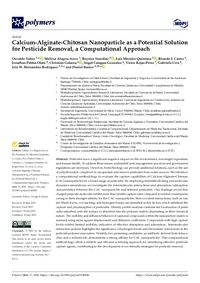Mostrar el registro sencillo de la publicación
Calcium-alginate-chitosan nanoparticle as a potential solution for pesticide removal, a computational approach
| dc.contributor.author | Yáñez, Osvaldo | |
| dc.contributor.author | Alegría-Arcos, Melissa | |
| dc.contributor.author | Suardiaz, Reynier | |
| dc.contributor.author | Morales-Quintana, Luis | |
| dc.contributor.author | Castro, Ricardo I. | |
| dc.contributor.author | Palma-Olate, Jonathan | |
| dc.contributor.author | Galarza, Christian | |
| dc.contributor.author | Catagua-González, Ángel | |
| dc.contributor.author | Rojas-Pérez, Víctor | |
| dc.contributor.author | Urra, Gabriela | |
| dc.contributor.author | Hernández-Rodríguez, Erix W. | |
| dc.contributor.author | Bustos, Daniel | |
| dc.date.accessioned | 2023-09-04T12:40:07Z | |
| dc.date.available | 2023-09-04T12:40:07Z | |
| dc.date.issued | 2023 | |
| dc.identifier.uri | http://repositorio.ucm.cl/handle/ucm/4949 | |
| dc.description.abstract | Pesticides have a significant negative impact on the environment, non-target organisms, and human health. To address these issues, sustainable pest management practices and government regulations are necessary. However, biotechnology can provide additional solutions, such as the use of polyelectrolyte complexes to encapsulate and remove pesticides from water sources. We introduce a computational methodology to evaluate the capture capabilities of Calcium-Alginate-Chitosan (CAC) nanoparticles for a broad range of pesticides. By employing ensemble-docking and molecular dynamics simulations, we investigate the intermolecular interactions and absorption/adsorption characteristics between the CAC nanoparticles and selected pesticides. Our findings reveal that charged pesticide molecules exhibit more than double capture rates compared to neutral counterparts, owing to their stronger affinity for the CAC nanoparticles. Non-covalent interactions, such as van der Waals forces, π-π stacking, and hydrogen bonds, are identified as key factors which stabilized the capture and physisorption of pesticides. Density profile analysis confirms the localization of pesticides adsorbed onto the surface or absorbed into the polymer matrix, depending on their chemical nature. The mobility and diffusion behavior of captured compounds within the nanoparticle matrix is assessed using mean square displacement and diffusion coefficients. Compounds with high capture levels exhibit limited mobility, indicative of effective absorption and adsorption. Intermolecular interaction analysis highlights the significance of hydrogen bonds and electrostatic interactions in the pesticide-polymer association. Notably, two promising candidates, an antibiotic derived from tetracycline and a rodenticide, demonstrate a strong affinity for CAC nanoparticles. This computational methodology offers a reliable and efficient screening approach for identifying effective pesticide capture agents, contributing to the development of eco-friendly strategies for pesticide removal. | es_CL |
| dc.language.iso | en | es_CL |
| dc.rights | Atribución-NoComercial-SinDerivadas 3.0 Chile | * |
| dc.rights.uri | http://creativecommons.org/licenses/by-nc-nd/3.0/cl/ | * |
| dc.source | Polymers, 15(14), 3020 | es_CL |
| dc.subject | Virtual screening | es_CL |
| dc.subject | Ensemble-docking | es_CL |
| dc.subject | Molecular dynamics simulation | es_CL |
| dc.subject | Alginate-chitosan | es_CL |
| dc.subject | Nanoparticle | es_CL |
| dc.subject | Polyelectrolyte matrix | es_CL |
| dc.subject | Pesticide adsorption | es_CL |
| dc.title | Calcium-alginate-chitosan nanoparticle as a potential solution for pesticide removal, a computational approach | es_CL |
| dc.type | Article | es_CL |
| dc.ucm.facultad | Facultad de Medicina | es_CL |
| dc.ucm.indexacion | Scopus | es_CL |
| dc.ucm.indexacion | Isi | es_CL |
| dc.ucm.uri | mdpi.com/2073-4360/15/14/3020 | es_CL |
| dc.ucm.doi | doi.org/10.3390/polym15143020 | es_CL |



